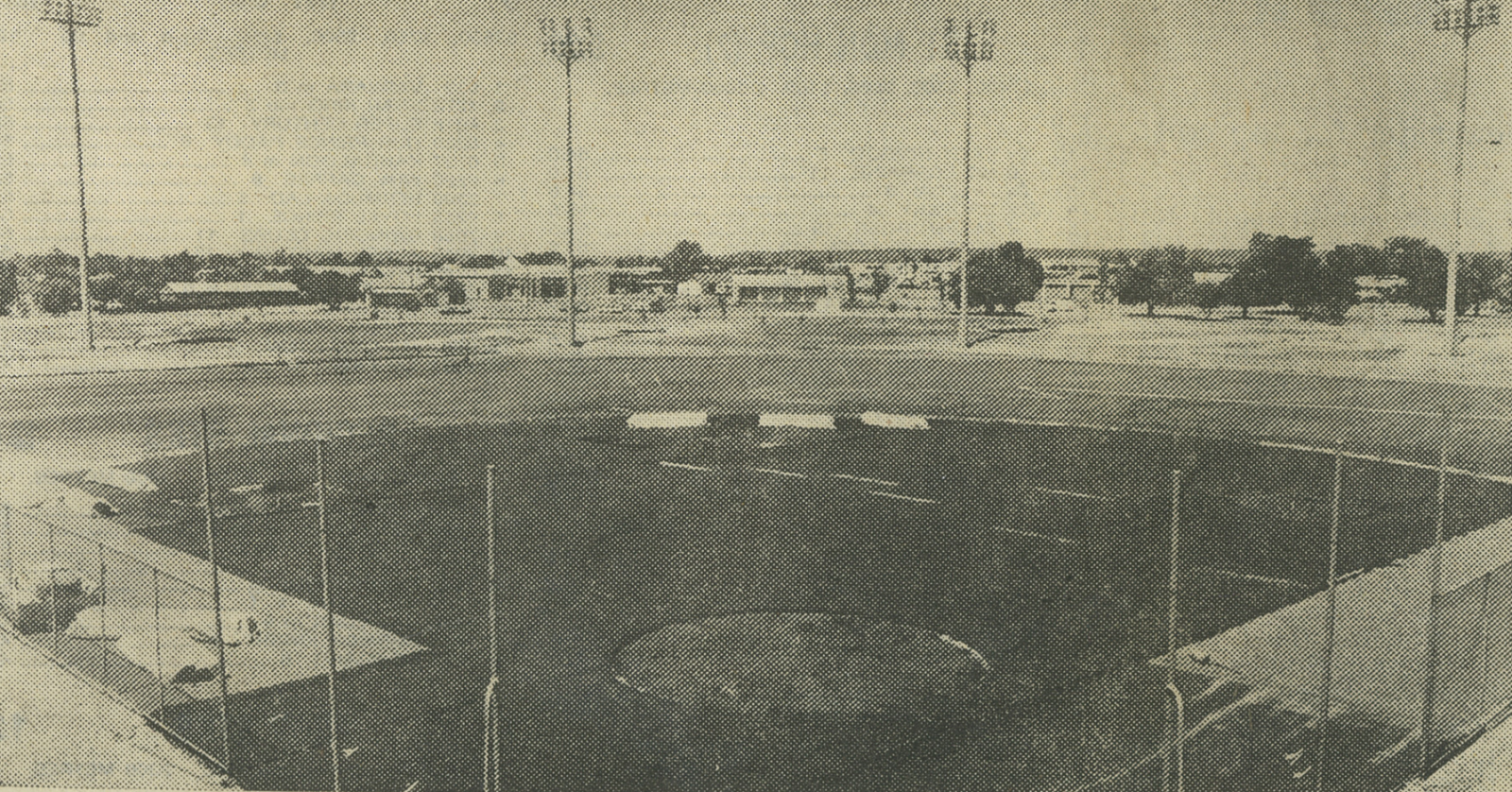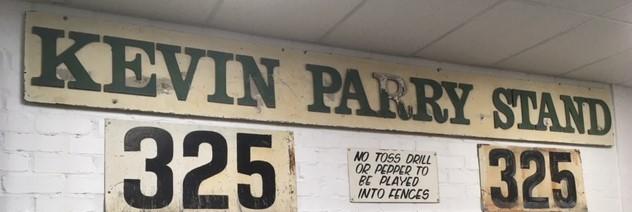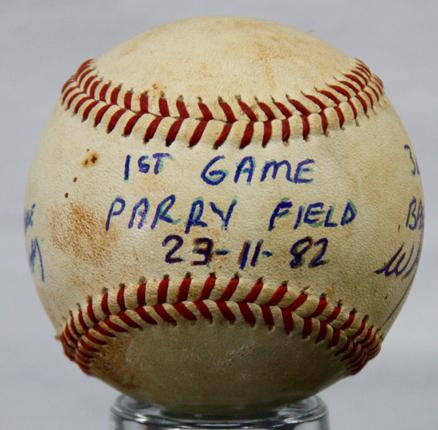Baseball WA's first purpose-built baseball stadium
Baseball WA Museum and Archives
The concept of a ground, specifically designed for baseball, was first mooted in 1956 by Perth businessman Kevin Parry, in discussions with the Perth City Council. A ground at Lake Monger was eventually earmarked but nothing transpired for the next 20 years, in spite of Kevin’s enthusiasm.
Kevin Parry eventually went on to represent Western Australia in the Claxton Shield Baseball Series for 10 seasons between 1959 and 1969, and received All-Australian selection in 1963. He later coached Northern Suburbs in the State League competition.

Kevin Parry – State baseball player and businessman.
[Courtesy of the 'Daily News'.]
In the 1950s baseball in Perth was a major sport but the West Australian Baseball League (WABL) had to share other sporting grounds in order to play games. Subiaco Oval, Leederville Oval, the Western Australian Cricket Association (WACA) ground, Gloucester Park and the Esplanade had been venues for State, interstate and Claxton Shield series held by the WABL since 1936.
The first win of the Claxton Shield by Western Australia occurred in 1952, which indicated that WA could match other States in baseball at a highly competitive level. Several WA players from the team were also selected for the All-Australian Team following that Claxton Shield Series.
In 1975, a ground at the Lake Monger Sporting Complex was eventually earmarked but nothing transpired in spite of Kevin’s enthusiasm.
"The proposed City of Perth sporting complex included car parking, baseball ground, velodrome, cricket, soccer and passive recreation."
By July 1975, the initial planning of the facility had been completed by the City of Perth and in a letter dated 16th July 1975, the City of Perth Town Clerk, G.O. Edwards, advised that the Council required assurance in the WABL’s ability to finance the baseball ground and the WABL Headquarters. It would appear that the WABL could only support the cost of filling and, although further follow-up meetings were arranged, an impasse had developed.
In the following years, the correspondence between the WABL and the Perth City Council remained extremely positive regarding the development, particularly as 1979 marked the 150th anniversary of the founding of WA. To coincide with the project, the Japanese team Kagoshima were scheduled to visit Perth.
However, the plan was dealt a severe blow when the Federal Government announced in 1976 that there would be no further funding to amateur sporting groups as a strategy to lowering the spiralling inflation rate. This total ‘wipe out’ completely upset the WABL plans.
Accordingly, the WABL made plans for a motion to be introduced at the next WA State Liberal Party meeting but it was defeated. The motion read:
“That substantial financial assistance to national sporting organisations be reintroduced this financial year…..”
It was in 1978 that the catalyst for a specialised ground for baseball emerged. Victoria Park at that time was a leading baseball club but financially broke. The Club approached the Belmont City Council to significantly upgrade their baseball home at Forster Park in Belmont, so that they could entice imports from overseas. They attracted Don Knapp from Oregon (and later Bob Ossey) as part of their new program and Kevin Parry agreed to financially support the initiative.
Specifically, Victoria Park also wanted floodlights and licensed premises. The Council, however, knocked them back but the Club was encouraged to pursue the idea of a new stadium.
So, the concept of Parry Field was born, with several parties coming to the table to financially support the project. Both Bob Ossey and Don Knapp were instrumental in the discussions to bring the Parry Field project to fruition.
Kevin Parry, after whom the Stadium was named, provided $100,000 with other money coming from the Belmont City Council ($150,000), the WA State Government ($100,000), the WA Baseball League ($20,000), Victoria Park ($100,000 over 15 years) and the Federal Government, under Prime Minister Malcolm Fraser, finally providing $480,000.
The area selected for the new stadium was near the Belmont Bowling Club (known as Grove Farm) which had been the headquarters of WA Rugby League and the Ascot Soccer Club.

Parry Field during construction. [Courtesy of the 'Daily News'.]
Parry Field Baseball Park: A dream come true - 1982 newspaper articles
The floodlights were the best in Australia but accounted for 40 per cent of the cost. When the stadium officially opened for its first Night Series game, people driving along the Great Eastern Highway were surprised to see an immense area brightly lit.
There were eight concrete towers approximately 35 metres tall with the lighting provided by 164 Canadian-made mercury globes. The average illumination was 700 lux in the infield and 500 lux in the outfield, which were similar recommendations for Triple AAA levels in American baseball. This was more than the lighting used at the Commonwealth Hockey Stadium in Bentley.
Each light pole weighed 10 tonnes and could resist a wind speed of 144 kph. The footings weighed 13 tonnes and were embedded 1.8 metres into the ground. A lightning conductor was placed on the top of each mast.
The distance down the left and right field lines from home plate to the home run fence was 97.5 metres (325 feet) with 188 metres (387 feet) to centrefield. The ‘warning track’ on either side of the diamond and in front of the home run fence was made of crushed red brick. The pitching mound was made of fibreglass rubber. There was also an artificial infield of synthetic turf known as Westurf Synthetic Turf.

The first game at the stadium was played on November 23, 1982 between Morley Eagles and Victoria Park. Tony Adamson was the first player to hit a home run in the 6-5 win by Morley Eagles.

Game ball used in the first game played at Parry Field.
Baseball from 1st game played at Parry Field - 1982 | Collections WA
The ground was officially opened by the Federal Minister for Home Affairs, the Hon. Tom McVeigh, during the opening ceremony of the 1983 Claxton Shield Series. This ceremony and two of the Claxton Shield games were televised nationally by the ABC. Five cameras were used around the field.
The dreams of Kevin Parry, Neville Pratt, Doug Corker, Bob Ossey and Don Knapp were finally realised. Kevin Parry was honoured with the naming of the facility.
This was followed in 1985 by the 13th Asian International Baseball Series which was a landmark event for Australian baseball, with Japan, Taiwan, China and Korea participating. The Australia v. Japan game was a sell-out, with Australia beating Japan. However, Japan went on to win the series against Taiwan.
Over the next few years State League baseball, Claxton Shield, Night Series baseball and international baseball games, were regular features at Parry Field. However, on the eve of the 17th Asian Championships in 1993, Belmont City Council made a radical change to the venue by changing the title to the 'Belmont International Baseball Stadium'.
This move shocked, upset and infuriated the local baseball fraternity who had seen Kevin Parry's 30-year vision finally come to fruition 10 years earlier. Parry Field had been synonymous with Kevin Parry and baseball in general throughout Australia and Asia and suddenly 'johnny-come-lately' council administrators were disregarding history. Opponents of the move drew a parallel with the concept of suddenly changing the name of Candlestick Park in San Francisco. It just wouldn't happen.
In recognition of Kevin's contribution to the development of baseball, the Council recommended that the name 'Kevin Parry' would be perpetuated with the naming of the main grandstand to be known as the 'Kevin Parry Stand'. The ABC commentators covering the championships said they would continue to refer to the stadium as 'Parry Field'. Today, many older baseballers from that era still refer to the stadium as 'Parry Field' in order to protect its history and heritage.
The ground was also the first sporting venue in Western Australia to become entirely smoke-free through baseball’s sponsorship agreement with the State Government’s Health Promotion Foundation, Healthway. In 2023, still supports baseball’s activities after a 32-year association,

Bygone signage of baseball's long association with Healthway in Western Australia.
The demise and destruction of Parry Field approximately 10 years later was a complex mixture of politics, business discontent and the influence of a nearby housing development. The influence of business and a change in the elected Belmont City Council members gradually resulted in the closure of the Parry Field.
The mantle of having the finest baseball stadium in Australia was no longer.
Today the ground is just an unplanned recreation area used by dog walkers.
References
- Clark, J. (2003) ‘A History of Australian Baseball – Time and Game’.
- ‘Parry Field Plays Ball’, Sunday Independent Newspaper, November 28, 1982 p.61.
- ‘Baseball enters a new era’ by Alan Newman, The Western Mail, Saturday, November 13, 1982 p.107.
- ‘Stadium is nation’s finest’ The Times, Tuesday, November 23, 1982 p.10-11.
- ‘Thank You, Kevin Parry’ Baseball from the Bull-Pen, 1982.
- ‘Ballpark is a dream come true’ Daily News, Monday, November 22, 1982.
- ‘Parry Field Statistics’ Neville Pratt, Acting Chairman, Parry Field Committee, (date unknown).
- 'Field name change upsets Vice-Patron", News Chronicle, March 3, 1993
